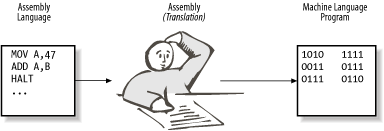Chapter 2. The Basics of Program Writing
| I l @ ve RuBoard |
Computers are very powerful tools that can store, organize, and process a tremendous amount of information. However, they can't do anything until someone gives them detailed instructions. Communicating with computers is not easy. They require instructions that are exact and detailed. Wouldn't life be easier if we could write programs in English? Then we could tell the computer, "Add up all my checks and deposits, and tell me the total," and the machine would balance our checkbooks. But English is a lousy language when you must write exact instructions. The language is full of ambiguity and imprecision. Grace Hopper, the grand old lady of computing, once commented on the instructions she found on a bottle of shampoo:
She tried to follow the directions, but she ran out of shampoo. (Wash-rinse-repeat. Wash-rinse-repeat. Wash-rinse-repeat. . . .) Of course, we can try to write in precise English. We'd have to be careful and make sure to spell everything out and include instructions for every contingency. If we worked really hard, we could write precise English instructions, right? As it turns out, there is a group of people who spend their time trying to write precise English. They're called the government, and the documents they write are called government regulations. Unfortunately, in their effort to make the regulations precise, the government also has made the documents almost unreadable. If you've ever read the instruction book that comes with your tax forms, you know what precise English can be like. Still, even with all the extra verbiage the government puts in, problems can occur. A few years ago California passed a law requiring all motorcycle riders to wear a helmet. Shortly after this law went into effect a cop stopped a guy for not wearing a helmet. The man suggested the police officer take a closer look at the law. The law had two requirements: 1) that motorcycle riders have an approved crash helmet and 2) that it be firmly strapped on. The cop couldn't give the motorcyclist a ticket because the man did have a helmet firmly strapped on ”to his knee. So English, with all its problems, is out as a computer language. Now, how do we communicate with a computer? The first computers cost millions of dollars, while at the same time a good programmer cost about $6,000 a year. Programmers were forced to program in a language where all the instructions were reduced to a series of numbers , called machine language . This language could be directly input into the computer. A typical machine-language program looks like this: 1010 1111 0011 0111 0111 0110 .. and so on for several hundred instructions Whereas machines "think" in numbers, people don't. To program these ancient machines, software engineers would write out their programs using a simple language where each word would stand for a single instruction. This was called assembly language because the programmers had to manually translate, or assemble, each line into machine code. A typical program might look like: Program Translation MOV A,47 1010 1111 ADD A,B 0011 0111 HALT 0111 0110 .. and so on for several hundred instructions This process is illustrated in Figure 2-1. Figure 2-1. Assembling a program Translation was a difficult, tedious , exacting task. One software engineer decided this was a perfect job for a computer, so he wrote a program, called an assembler , that would do the job automatically. He showed his new creation to his boss and was immediately chewed out: "How dare you even think of using such an expensive machine for a mere `clerical' task?" Given the cost of an hour of computer time versus the cost of an hour of programmer's time, this was not an unreasonable attitude. Fortunately, as time passed the cost of programmers went up and the cost of computers went down. So it became more cost-effective to let the programmers write programs in assembly language and use a program called an assembler to translate the programs into machine language. Assembly language organized programs in a way that was easier for the programmers to understand. However, the program was more difficult for the machine to use. The program had to be translated before the machine could execute it. This was the start of a trend. Programming languages became more and more convenient for programmers to use and started requiring more and more computer time to translate them into something useful for computers. Over the years a series of high-level languages has been devised. These languages are attempts to let programmers write in something that is easy for them to understand and also precise and simple enough for computers to understand. Early high-level languages were designed to handle specific types of applications. FORTRAN was designed for number crunching ; COBOL, for writing business reports ; and PASCAL, for student use. (Many of these languages have far outgrown their initial uses. It is rumored that Nicklaus Wirth has said, "If I had known that PASCAL was going to be so successful, I would have been more careful in its design.") Later on, Brian Kernighan and Dennis Ritchie developed C and Bjarne Stroustrup turned it into C++. |
| I l @ ve RuBoard |
EAN: 2147483647
Pages: 364